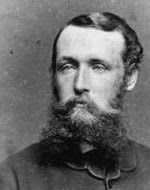
Just as a follow up to my earlier post about Patrols in the Sudan. I finished reading (and rereading) these rules and am still just as impressed as before. But I wanted to clarify a few points. These rules are designed for (for lack of a better word) guerrilla attacks on patrols of regulars and thus would not be suitable (in their pure form) for larger set-piece battles. Now that's not a weakness in my book since most Colonial Rules are (i.m.h.o.) completely unable to deal with this very type of warfare.
- First of all, no one wants to paint figures and then only put them on the table for a round of melee. Through it's split placement, terrain removal and scouting mechanisms PITS allows figures to be on the table even when "hidden".
- Secondly, those same mechanisms allow a better simulation of the uncertainties faced by regular European troops in an environment where the enemy's situation is unknown.Though it might feel weird for some terrain to disappear or appear out of nowhere it does integrate the uncertainties of Patrolling and the fact that seemingly innocuous landscape features may harbor unknown danger.
- Thirdly one is not hampered by overly large units. If you want you can use a large 21 figure TSATF sized unit, but(more typically)you will be using a company broken into smaller detachments.
- How one would deal with savvy colonial Auxiliaries (such as the Armed Constabulary of New Zealand, Sikhali Horse of Natal, Punjab Frontier Force, etc.) in PITS I'm not sure, but I would guess that a simple bonus to Scouting rolls would suffice.
Which campaigns would PITS be suitable for?
- Any Eastern American warfare pitting Europeans against various Indian nations (Pontiac's War, for example).
- Campaigns against the Maroons of the Caribbean and South America (for example, Jamaica mid 18th century)
- NW Frontier
- Apache Wars
- Maori Wars of the late 1860s
- Ashante Campaign
- As well as all the other campaigns I mentioned in my earlier post.
(The photo shows Gilbert Mair, of the NZ Armed Constabulary, one of Te Kooti's primary opponents.)




3 comments:
Scott,
I agree with your assessment on PITS. I also plan on trying it with some FFL in the desert along with the Arab revolt.
I did read a blog that the victory points are a bit off for the regulars to actually win. This was by a small group who has played it a number of times. I guess we will have to see. I really like that it is based on a company, as my FOW1918 stuff is so it should make it very transferable.
Chris
What do you think about the Boer Wars?
Yeah, FFL is an good choice that I overlooked. Really the system would work for hundreds of conflicts from 1620-1939 with very little modification (maybe upping the cost to fire for older firearms, down for magazine rifles ??). I think that it would definitely be appropriate for many of the smaller actions of the Second Boer War.
I think I read the same Blog. I'm assuming that that critique was posted when the both forces were using 300 points each. There is a note on the Peter Pig website that says in the newer edition the A/E player has an increased point base due to this very complaint. In my rules the A/E player gets 360 points. When I play (which could be months from now)I will try that amount.
yours
SP
Post a Comment